
Mar 20
/
Alef Dias
Grains, Oilseeds and Livestock Weekly Report - 2024 03 20
Back to main blog page
Wheat: China brings more bearish fundamentals
- In the last week, Chinese wheat importers have canceled or postponed around 1M mt of cargoes of Australian wheat, according to trade sources. News of the moves came shortly after the US government reported the cancellation of more than 500,000 tons of US wheat exports to China the previous week.
- Cargo cancellations are an indicator of a bearish outlook on the part of buyers, either because they are doing so in order to buy again more cheaply or because there is less demand.
- Looking at the import estimates for the current marketing year, a slowdown in Chinese purchases is expected, given that China is expected to import 2M mt less than in the previous season.
- The outlook for the next harvest could also lead to a reduction in imports. Despite the small change in the planted area, current harvest conditions are satisfactory.
Introduction
Last week, China added downward pressure to wheat contracts by canceling and postponing purchases from the US and Australia. Despite being the largest wheat producer in the world, China's relevance on the demand side has grown dramatically in recent years due to the increase in domestic consumption.
Given this relevance and recent events, let's update our view of Chinese imports, both for this end of the 23/24 marketing year and for the next one.
Purchases canceled and delayed amid low prices
Chinese wheat importers have canceled or postponed around 1M mt of cargoes of Australian wheat, according to trade sources. News of the moves came shortly after the US government reported the cancellation of more than 500,000 tons of US wheat exports to China the previous week.
Traders also reported that commercial companies have vacated shipping slots in several Australian ports that were reserved for cargoes bound for China. The country is the biggest buyer of Australian wheat, and probably booked the cargoes four or five months ago, when prices were higher.
Canceling loads is a bearish indicator. Whether they're doing it to buy again more cheaply or because there's less demand, it's still a bearish view on the market. But will these movements continue in the coming months?
Data still shows strength in demand, but estimates point to a slowdown
Despite the recent cancellations, recent import data points to a strong pace of purchases so far. In the 23/24 crop year, the pace is very similar to the previous crop year, when China imported a record volume of wheat and became the world's largest wheat importer.
Looking at the import estimates for the current season, a slowdown in Chinese purchases is expected, given that China is expected to import 2M mt less than in the previous harvest.
Looking at the import estimates for the current season, a slowdown in Chinese purchases is expected, given that China is expected to import 2M mt less than in the previous harvest.
Fig. 1: Cumulative wheat imports - China (M mt)
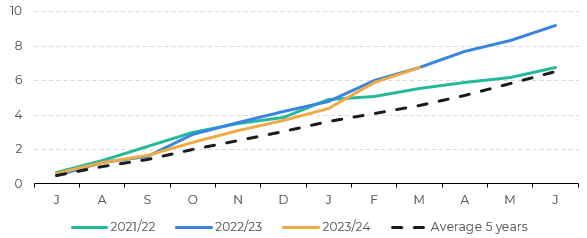
Source: Refinitiv
Despite the lower stock-to-use ratio of recent years, the country still has a much more comfortable situation than most of the top importers, which allows China to postpone its purchases if necessary or interesting.
Fig. 2: Ending stocks and Stock/Use (M mt)
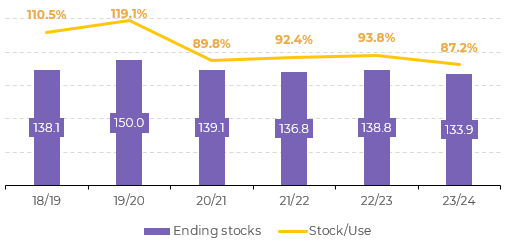
Source: USDA
Next harvest also means lower imports
In addition to expectations of higher yields in Russia and the US next season, Chinese production should also be higher than in the 23/24 season, when productivity and quality were heavily impacted by heavy rains at the end of the season.
Despite the slight change in the planted area, current crop conditions are satisfactory. After the strong cold wave in February, which could cause some damage to winter wheat in the advanced stages of development in the south, warm temperatures have returned.
Fig. 3: Wheat Supply and Demand China (M mt)
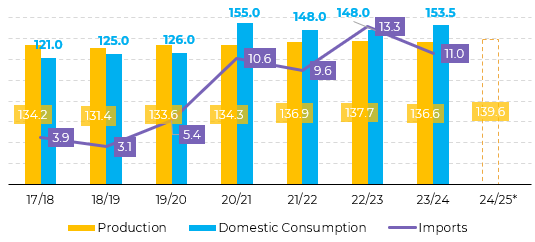
Source: USDA. *Refinitiv Estimate
Fig. 4: Soil moisture in the main producing regions - China
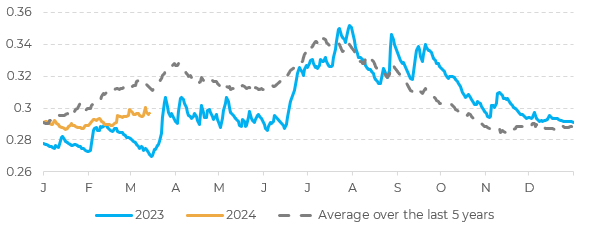
Source: Refinitiv
Most winter wheat crops in the north will soon come out of dormancy. Rainfall during the winter was close to or slightly above average, providing adequate soil moisture for the vegetative development of winter wheat in the spring.
Fig. 5: Precipitation forecast - China (% of normal)
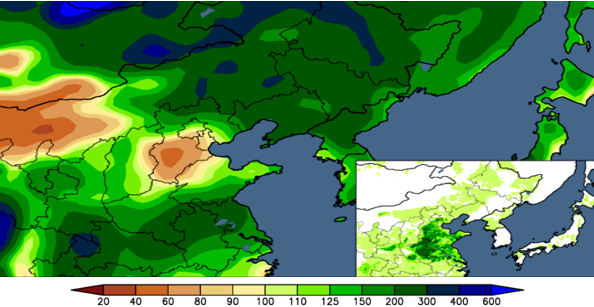
Source: World AgWeather (wheat production shown inside)
Fig. 6: Temperature forecast - China (difference from normal, ºF)
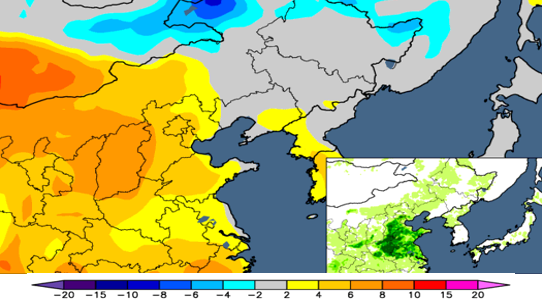
Source: World AgWeather (wheat production shown inside)
In summary
As one of the world's main importing countries, fundamentals from China continue to have a significant impact on wheat futures prices. Last week's events showed that Chinese buyers have a bearish view of wheat, which should lead to a slowdown in imports in the coming months.
Current estimates corroborate this thesis, as do the prospects for the 24/25 harvest. As a result, China should continue to put downward pressure on wheat prices throughout the year.
Weekly Report — Grains and Oilseeds
Written by Alef Dias
alef.dias@hedgepointglobal.com
Reviewed by Pedro Schicchi
pedro.schicchi@hedgepointglobal.com
pedro.schicchi@hedgepointglobal.com
www.hedgepointglobal.com
Disclaimer
This document has been prepared by hEDGEpoint Global Markets LLC and its affiliates ("HPGM") exclusively for informational and instructional purposes, without the purpose of creating obligations or commitments with third parties, and is not intended to promote an offer, or solicitation of an offer, to sell or buy any securities or investment products. HPGM and its associates expressly disclaim any use of the information contained herein that may result in direct or indirect damage of any kind. If you have any questions that are not resolved in the first instance of contact with the client (client.services@hedgepointglobal.com), please contact our internal ombudsman channel (ouvidoria@hedgepointglobal.com) or 0800-878-8408 (for clients in Brazil only).
Contact us
hedgepointhub.support@hedgepointglobal.com
ouvidoria@hedgepointglobal.com
Funchal Street, 418, 18º floor - Vila Olímpia São Paulo, SP, Brasil
This page has been prepared by Hedgepoint Schweiz AG and its affiliates (“Hedgepoint”) solely for informational and instructional purposes, without the purpose of instituting obligations or commitments to third parties, nor is it intended to promote an offer, or solicitation of an offer of sale or purchase relating to any securities, commodities interests or investment products. Hedgepoint and its associates expressly disclaim any use of the information contained herein that directly or indirectly result in damages or damages of any kind. Information is obtained from sources which we believe to be reliable, but we do not warrant or guarantee the timeliness or accuracy of this information. The trading of commodities interests such as futures, options, and swaps involves substantial risk of loss and may not be suitable for all investors. You should carefully consider wither such trading is suitable for you in light of your financial condition. Past performance is not necessarily indicative of future results. Customers should rely on their own independent judgement and/or advisors before entering in any transaction.Hedgepoint does not provide legal, tax or accounting advice and you are responsible for seeking any such advice separately.Hedgepoint Schweiz AG is organized, incorporated, and existing under the laws of Switzerland, is filiated to ARIF, the Association Romande des Intermédiaires Financiers, which is a FINMA-authorized Self-Regulatory Organization. Hedgepoint Commodities LLC is organized, incorporated, and existing under the laws of the USA, and is authorized and regulated by the Commodity Futures Trading Commission (CFTC) and a member of the National Futures Association (NFA) to act as an Introducing Broker and Commodity Trading Advisor. HedgePoint Global Markets Limited is Regulated by the Dubai Financial Services Authority. The content is directed at Professional Clients and not Retail Clients. Hedgepoint Global Markets PTE. Ltd is organized, incorporated, and existing under the laws of Singapore, exempted from obtaining a financial services license as per the Second Schedule of the Securities and Futures (Licensing and Conduct of Business) Act, by the Monetary Authority of Singapore (MAS). Hedgepoint Global Markets DTVM Ltda. is authorized and regulated in Brazil by the Central Bank of Brazil (BCB) and the Brazilian Securities Commission (CVM). Hedgepoint Serviços Ltda. is organized, incorporated, and existing under the laws of Brazil. Hedgepoint Global Markets S.A. is organized, incorporated, and existing under the laws of Uruguay. In case of questions not resolved by the first instance of customer contact (client.services@Hedgepointglobal.com), please contact internal ombudsman channel (ombudsman@hedgepointglobal.com – global or ouvidoria@hedgepointglobal.com – Brazil only) or call 0800-8788408 (Brazil only).Integrity, ethics, and transparency are values that guide our culture. To further strengthen our practices, Hedgepoint has a whistleblower channel for employees and third-parties by e-mail ethicline@hedgepointglobal.com or forms Ethic Line – Hedgepoint Global Markets.Security note: All contacts with customers and partners are conducted exclusively through our domain @hedgepointglobal.com. Do not accept any information, bills, statements or requests from different domains and pay special attention to any variations in letters or spelling, as they may indicate a fraudulent situation.“HedgePoint” and the “HedgePoint” logo are marks for the exclusive use of HedgePoint and/or its affiliates. Use or reproduction is prohibited, unless expressly authorized by HedgePoint. Furthermore, the use of any other marks in this document has been authorized for identification purposes only. It does not, therefore, imply any rights of HedgePoint in these marks or imply endorsement, association or seal by the owners of these marks with HedgePoint or its affiliates.

